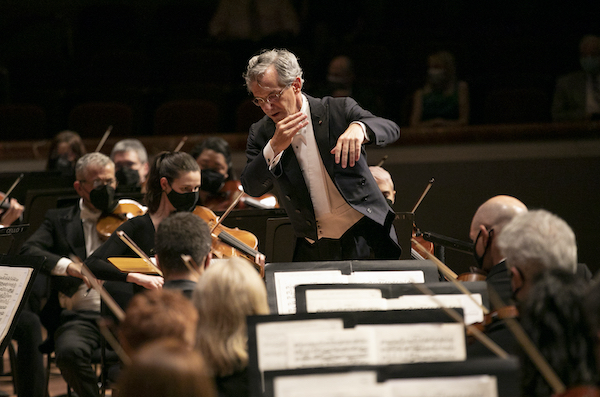Dallas Symphony opens season at full strength and with customary brilliance

After a pandemic year of chamber orchestra performances, the Dallas Symphony Orchestra opened its 2021-2022 season in full force Thursday night at the Meyerson Symphony Center. Led by music director Fabio Luisi, the program offered a strong return to form and the kind of familiar brilliance not heard in the hall since March of last year.
Opening the program was Frederick Shepherd Converse’s The Mystic Trumpeter. Inspired by Walt Whitman’s poem of the same title, Converse sets his orchestral narrative over five episodic passages played attacca, with each of the parts based on a specific section of Whitman’s poem. They range in theme and mood, from the first Mystery and Peace, through Love, War and Struggle, Humiliation, and finally Joy.
Converse’s work is a discursive yet lush tone poem that sways with the redolence of a Tchaikovsky ballet. Luisi and the DSO were comparably subtle in delivery, even through the more athletic passages of the tumultuous third movement. Luisi led a flowing cohesive performance with an even-tempered balance of color between horns and strings. Acting principal trumpet L. Russell Campbell expertly provided the opening fanfare and rhapsodic main theme, reiterated by concertmaster Alexander Kerr and oboist Willa Hennigman.
Another orchestra member, organist Bradley Hunter Welch, was featured in the evening’s centerpiece, Aaron Copland’s Symphony for Organ and Orchestra. Copland’s unconventional integration of jazz-inspired rhythms and note groupings garnered a mixed response (jeers and applause) from its second performance in February of 1925. Consequently, Copland arranged a second version without organ, simply titled First Symphony.
The original work, however, was given a fine reading by Luisi, Welch and the DSO. Welch’s command of color showed in the dramatic shifts between light and dark. Principal flutist David Buck’s playing of the first theme was light and lovely, and the muted effect of pizzicato strings made for a balanced texture throughout the first movement.
The middle Scherzo is the dramatic center of the work and most emblematic of Copland’s experimentation, with the usual trio replaced by a blues section. The winds maneuvered the uneven rhythmic structures of the opening passage with ease, and again, Kerr provided a telling solo expression of the lyrical second theme. Saxophone and clarinet provide the unexpected blues section with appropriate shading. Welch was stately and somewhat reserved at the console during the Lento finale.
Brahms’ Symphony No. 1 closed the evening. Pressured by his contemporaries to engage with symphonic works, Brahms once stated, “You have no idea how the likes of us feel when we hear the tramp of a giant like [Beethoven] behind us.” Over 20 years would pass before his first symphony was completed in 1876 and first performed under the composer’s direction at Mannheim.
Here, Luisi prioritized mood and color over drama, from the surging introduction of the opening Allegro to the sweeping close of the finale.
The timpani in the first movement might have done with a bit of dynamic tempering, though the august rhythmic coordination of the ensemble made for a compelling lead into the stormy main theme. The lamenting second movement showcased a tender oboe solo and another lovely expression in first violin. At times, the strings collectively soared above the texture.
Replacing the usual Scherzo with a more graceful song-like movement, Brahms emphasizes soft woodwind colors, which members of DSO finessed evenly. After a poetically dark introduction, the final movement introduces an ominous back-and-forth between pizzicato strings, an effect that highlighted the breadth of this orchestra’s artistry.
Again, the roll of the timpani was at times overloud, but could be forgiven due in part to the welcome warmth of the ensuing horns emulating the echo of a shepherd’s horn. Treatment of the main theme of the finale, which recalls that of Beethoven’s Ninth, made the allusion evident before racing toward a brass-heavy, triumphant finish.
The program will be repeated 7:30 p.m. Friday and Saturday, and 3 p.m. Sunday. dallassymphony.org